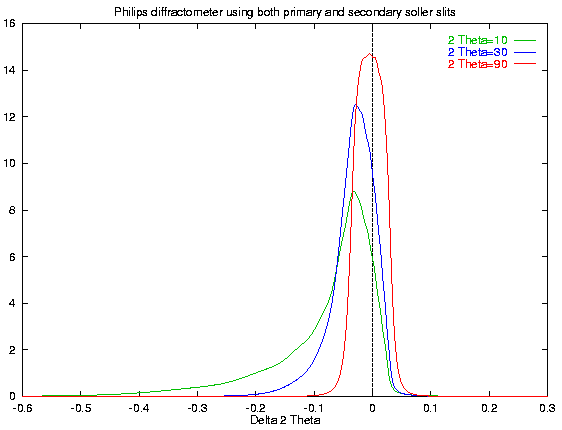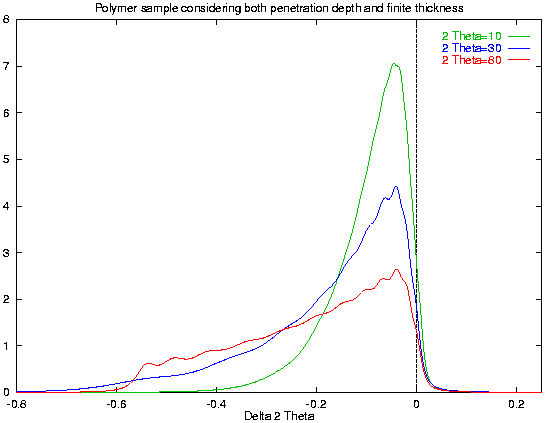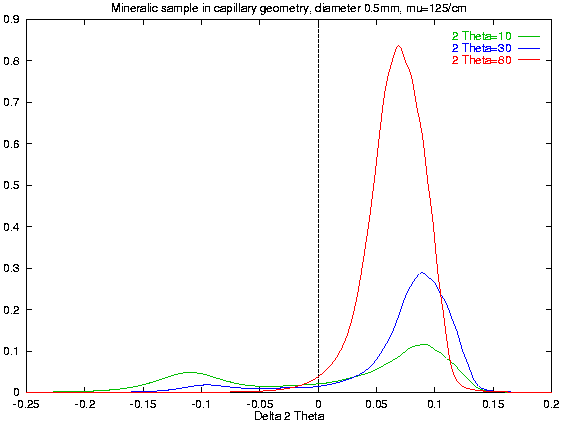Instrumental profiles for different geometries

explanation

explanation

explanation

explanation
This example shows the common case of both primary and secondary soller
slits collimator. It describes the slit system for the IUCR Rietveld Round
Robin (PbSO4). We reached a Rwp value of 1 per cent better than the best
result. The program was developed after the Rietveld Round Robin has finished.
Therefore this result is not published. The command file for the computation
is as follows:
VERZERR=\val\kristall\ringtest\ringverz
R=173
rh=100
pi=2*acos(0)
% Feinfokusroehre
FocusH=8
FocusW=0.04
PColl=0.5*4.45*pi/180
SColl=0.5*4.45*pi/180
HSlitR=rh
HSlitW=(R-rh)*1*pi/180
SamplH=10
SamplW=20
DetW=0.2
DetH=15
MonR=R+51
zweiTheta[1]=10
zweiTheta[2]=14
zweiTheta[3]=20
zweiTheta[4]=28
zweiTheta[5]=40
zweiTheta[6]=65
zweiTheta[7]=90
zweiTheta[8]=120
zweiTheta[9]=135
zweiTheta[10]=150
zweiTheta[11]=160
WMIN=10
WMAX=160
WSTEP=1
This is a measuring on a HZG 4 from the firm Seifert-FPM. Polymers commonly
show reflections at very low angles. Therefore, primary and secondary soller
slits are both in use. Please, remark the 1.6mm thick sample with
a mu=3.3/cm! The detector is a semiconductor one for Kbeta separation.
It's window (size of 8mm) was chosen instead of the monochromator crystal's
hight and position. The command file is as follows:
VERZERR=vjeh03
R=250
FocusH=10
FocusW=0.1
HSlitR=85
HSlitW=0.44
VSlitR=75
VSlitH=4
PColl=0.5/25
SamplD=12
DetW=0.22
DetH=8
MonR=R+8
zweiTheta[1]=3
zweiTheta[2]=4
zweiTheta[3]=5
zweiTheta[4]=6.5
zweiTheta[5]=8
zweiTheta[6]=10
zweiTheta[7]=14
zweiTheta[8]=20
zweiTheta[9]=28
zweiTheta[10]=40
zweiTheta[11]=60
zweiTheta[12]=80
T=1.6
D=T/0.53012
WMIN=3
WMAX=80
pi=2*acos(0)
WSTEP=2*sin(zweiTheta*pi/180)
GSUM=Y
This was a measuring at an 3000TT diffractometer in transmission. The
thickness of the specimen was estimated to 0.2mm. Because of the high
linear attenuation coefficient of 250/cm the intensity is lowered for more
than a magnitude. And there is a strong lowering of intensity for larger
2 theta angles. For compensation, this measuring was done without secondary
soller slits. The command file is as follows:
VERZERR=tran0205.ger
GEOMETRY=TRANSMISSION
R=250
D=0.08
T=0.2
HSlitR=R-150
HSlitW=0.2
VSlitR=R-80
VSlitH=17
FocusH=12
FocusW=0.04
DetH=14
MonR=R+50
DetW=0.5
SamplD=20
PColl=0.54/25
zweiTheta[1]=6
zweiTheta[2]=10
zweiTheta[3]=16
zweiTheta[4]=24
zweiTheta[5]=34
zweiTheta[6]=48
zweiTheta[7]=60
zweiTheta[8]=90
zweiTheta[9]=120
WMIN=6
WMAX=120
pi=2*acos(0)
WSTEP=3*sin(pi*zweiTheta/180)
This example shows the possibility of computation of capillary (or wire)
geometry. The parameters capillary diameter and linear attenuation
coefficient represent a realistic case for mineralic samples. Until now,
we have not really used this capillary geometry. Please remark the double-peak
at low angles, well known in Debye-Scherrer-films from high absorbing
specimens. You also can see the common fact of increasing intensity with
2 theta angle. The command file is as follows:
VERZERR=capillar
GEQ=capillar
GEOMETRY=CAPILLARY
R=250
FocusH=10
FocusW=0.1
HSlitR=85
HSlitW=0.44
VSlitR=75
VSlitH=4
PColl=0.5/25
SColl=0.5/25
DetW=0.22
DetH=8
MonR=R+8
zweiTheta[1]=3
zweiTheta[2]=4
zweiTheta[3]=5
zweiTheta[4]=6.5
zweiTheta[5]=8
zweiTheta[6]=10
zweiTheta[7]=14
zweiTheta[8]=20
zweiTheta[9]=28
zweiTheta[10]=40
zweiTheta[11]=60
zweiTheta[12]=80
WMIN=3
WMAX=80
pi=2*acos(0)
WSTEP=5*sin(zweiTheta*pi/180)
D=0.08
T=0.5





